From Mongolia, Genghis Khan and his hordes rode to conquer China
and most of the rest of all Asia!
Genghis Khan was one of the greatest warriors of all time. Surprisingly, he was also a good ruler between wars and Mongolian culture prospered under his leadership. Below you'll find information about him and free public domain pictures of an immense statue of the man the Mongolians call Chinggis Khaan. (That's the way it is spelled on the official Mongolian government website. "Gengis Khan", missing an "h", is not a correct spelling.)
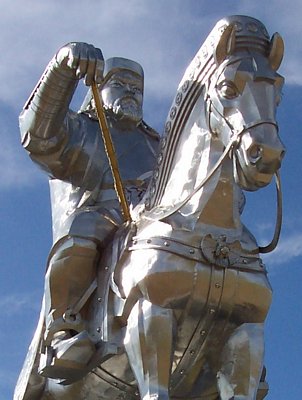
The population of Mongolia in 2007 was estimated at 2.7 million. That's not even a medium-size city in China! Yet many (most?) people in the world have heard of Mongolia's most famous leader - Genghis Khan. Led by him, Mongolian horsemen took over much of Asia, conquering areas and populations much larger than Mongolia's own. It's no wonder the Mongolians almost worship his memory and he has such a prominent place in Mongolia history.
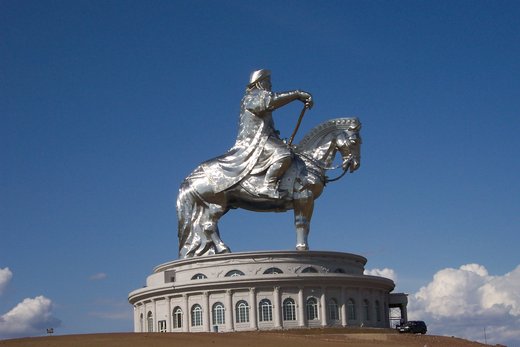
In fact, a friend of mine, Nick, who taught English in Mongolia for three years, tells of an interesting prophecy he heard from a man he called a "patriotic shaman". In the wild parts of Mongolia, there is still a lot of animist belief and shamans (think "witch doctors" and you won't be far off) are respected. This particular shaman said that Genghis Khan would be reborn and would lead Mongolia back to being the leading nation in the world. Nick heard the same story elsewhere too.
I don't think the belief is that it would literally be the same man come back to life, but rather a rebirth of his "spirit". Tibetan Buddhism and its beliefs of rebirth are also greatly respected in Mongolian culture, so merging some animism and Tibetan Buddhism could easily lead many Mongolians to believe that Genghis Khan's essence has been reborn again and again, continuing on to today. If one believes that, then it's not a long step to hope that, with the right conditions, that essence will be in a man who would act and lead as Genghis did.
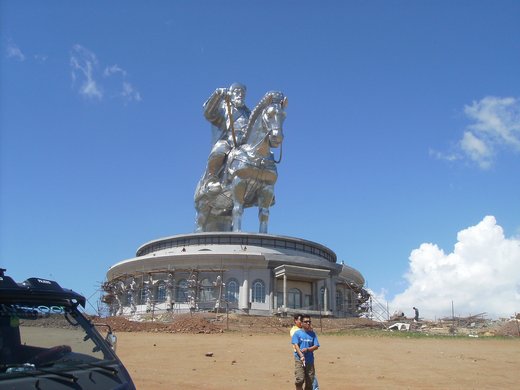
The immense statue pictured here is about 50 kilometers outside of Ulaan Baatar, the capital of Mongolia. You can judge the size of this statue from the van you see beside it in the photo below. An excellent New York Times article (Aug.3, 2009) about this Genghis Khan statue says it is 131 feet tall.
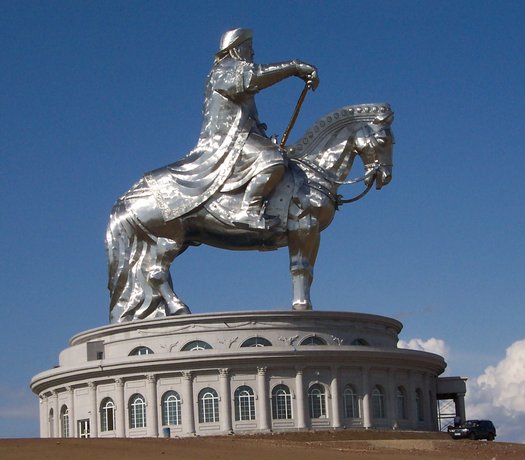
(Aside: Does the size of the man seem out of proportion to the horse? That's not an error. Mongolian horses are relatively small. See Mongolian Horse pictures to investigate more.)
Of course, this is being built up as a tourist attraction to be
finished sometime in 2009, so you might wonder if the average Mongolian
really cares about Genghis or just about using his fame to make some
money. Perhaps it's really both of those reasons that led them to
rename the biggest Mongolia airport "Genghis
Khan Airport". (Click here to
see it.)
Do you want some strong evidence that Mongolians truly respect Genghis Khan and his memory? Consider this. Mongolia banned family names for 70 years, hoping this would reduce the influence of powerful clans. That's why so many of the people in Mongolia used only one name, what in the West would be considered a first name. When the policy was repealed in the 1990s, people could choose their own surname and more than half of Mongolian people chose the great hero's clan name "Borjigin" (Master of the Blue Wolf).
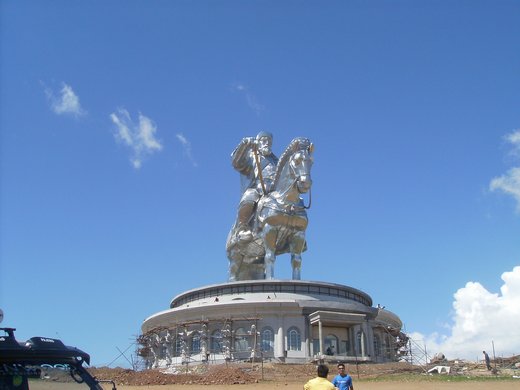
In fact, there's a traditional belief in Mongolia that all Mongolian men are descendants of Genghis Khan. It seems peculiar that anyone would believe something that sounds so outlandish, but DNA tracing has actually made this seem possible.
Sampling DNA from ten years of blood tests in the vast area covered by the Mongol empire showed that about 8% of the men tested share a certain genetic trait (a pattern of Y chromosomes) that indicates they have a common ancestor. That indicates about 16 million men with that trait - one out of every 200 men in the world!
It makes sense that to spread so widely the common ancestor must
have been somebody very important, whose influence (and children)
spread over large parts of Asia. The greatest leader of Mongolia's war
horde certainly fits that description. It is likely that those men have
Genghis Khan DNA.
Genghis and his army took whatever they wanted, and he himself had first pick of the women, so his genes spread quickly and widely. Reports from the time say his eldest son Tushi had 40 sons, and his grandson Kublai Khan had 22 legitimate sons (not to mention adding 30 women to his harem each year). His descendants could now be anywhere in the world! (For the humourous side of this, check out the Hitchhiker's Guide to the Galaxy.)
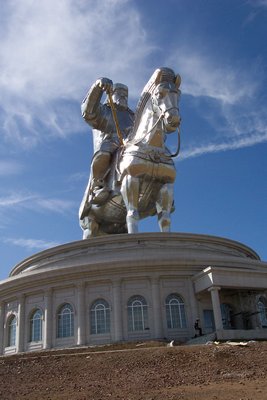
Here's a link to a great short article about this traditional belief
that Genghis Khan is the ancestor of all Mongolians, that is, that
Genghis Khan DNA is in all of them!
This
article, written in 2004
, mentions a restaurant in England offering free genetic testing to any
man who wanted to see if he had the Khan genetic trait. You even got a
free meal if you did!
In 2005, National Geographic aired a fascinating documentary called "Search for Adam" , part of which is about this tradition. Geneticist Spencer Wells and his research team sampled the DNA of several Mongolian men from a bar in California and found that half of them had this Genghis trait.
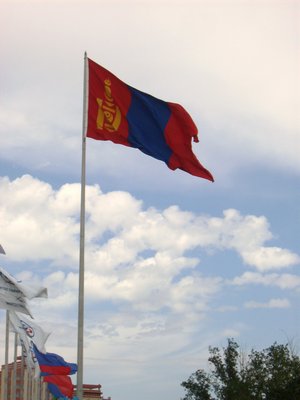
There are many places on the Web where you can read about Mongolia's
greatest warlord, but I recommend the Mongolian
government tourism website so
you can read what modern Mongolians think of him. (Look in the
"Discover Mongolia / History / Great Mongol Empire" section.) In
particular, the
site gives some information about "Chinggis Khaan" as a statesman, not
just a warrior.
The man who rose to power with the name Temujin united the Mongolian nomadic tribes in 1204. In 1206 he was given the title Genghis Khan, which means "King of Kings". He died in 1227 but his memory still leads and inspires the people of Mongolia.
Click here to see Genghis Khan
Airport in Mongolia.
Click here to see Mongolian nature
scenery.
Click here to see traditional
Mongolian clothing.
Return from Genghis Khan to Mongolia Pictures overview page
Go to Asia-Insider-Photos Home page: Public domain pictures of China, Mongolia, Tibet, and other Asian places.